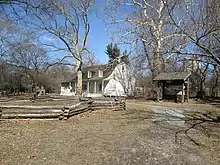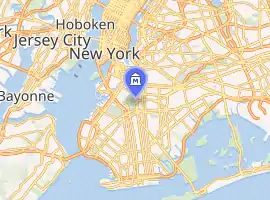Lefferts Historic House
The Lefferts Historic House is located within Prospect Park in Brooklyn, New York City. Built circa 1783, it is the former home of enslaved persons and the family of Continental Army Lieutenant Pieter Lefferts. It currently operates as a museum of the Leffertses' family life in Kings County.[1] The museum is part of the Historic House Trust,[2] owned by the New York City Department of Parks and Recreation and operated by the Prospect Park Alliance. It is a New York City designated landmark.
 | |

| |
| Established | 1783 |
|---|---|
| Location | Prospect Park, Brooklyn, New York, United States |
| Coordinates | |
| Website | www |
History
Pieter Lefferts, who served in the Flatbush militia and as a delegate to the New York Constitutional Convention, built the house on the 240-acre Lefferts family estate located on Flatbush Avenue near today's Maple Street.[3] [It was moved to its current site in 1918.] The structure’s Dutch architectural elements paid tribute to the Dutch heritage of the Lefferts family and of Kings County, but as Professor Daniel Bluestone has explained, its “central hallway framed by arches” were distinctly late-eighteenth-century American.[4]
The 1800 census recorded twelve enslaved residents and eight members of the Lefferts family in the household[5]--a testament to the fact that the Lefferts were one of the largest slaveholding families in the county. It was common for enslaved persons to live in the same dwelling with the enslaving families.[2] The Prospect Park Alliance, the Historic House Trust, and the NYC Parks Department currently make an interpretive decision to emphasize the Lefferts family as principal residents of the structure in their online materials.[6]
After the Revolutionary War “slavery actually strengthened in Kings County,” due to its profitability in what was then the breadbasket to nearby New York City. The Center for Brooklyn History refers to Kings County in the post-revolutionary era as a “slaveholding capital.” “Slaveholding families that became incredibly wealthy during this period included the Lefferts,” Even as the rest of the state moved toward emancipation in the post-revolutionary period, the Leffertses engaged actively in the “trade, sale, and purchase of enslaved people up until emancipation was enacted in New York in 1827” by the state legislature.[4] Many African-Americans in Brooklyn, by contrast, actively resisted slavery and worked toward emancipation during this period. The stubborn persistence of slavery and slaveholders like the Lefferts in Kings County well into the 1820s was, according to Wellman, the “geographic and social context for what would become the village of Weeksville”[7]--“one of the largest independent Black communities in pre-Civil War America.” The Prospect Park Alliance, the Historic House Trust, and the NYC Parks Department currently emphasize the role of the Lefferts family in freeing the people they enslaved.[8]
After 1827, the loss of unpaid labor forced the Lefferts family to change the way they could profit from their land and the types of crops they grew.[8] The Lefferts moved to a system of tenant farming to cultivate the land and sold some portions of the estate. In 1838, James Weeks purchased a part of the Lefferts estate to create Weeksville, which, Wellman writes, “represented a refusal to live … ‘in the shadow of slavery.’”[9]
Upon Pieter's death, the house had passed to his son John, who built a large rear addition to the house in the 1850s, and then John's daughter Gertrude Lefferts Vanderbilt, who wrote about her family, her community and the house in her 1881 book, The Social History of Flatbush.[9] This account by a member of the Lefferts family is one of the only sources cited in the historical summary published on websites of the Historic House Trust and the Prospect Park Alliance. The house remained in the Lefferts family for at least four generations.
Development was threatening Brooklyn's rural setting by the end of the 19th Century and in 1917, John Lefferts' estate offered the family's home to the City of New York with the condition that the house be moved onto city property as a means of protection and historic preservation. The house was moved six blocks to Prospect Park.[3] Preservationists made a decision to remove the 1850s rear wing of the building to emphasize its post-revolutionary-era appearance. This decision, “according to Bluestone, “introduced a strain of discontinuity between the Lefferts homestead and its place in Flatbush history:”[10]
Doubling down on the post-revolutionary period, in 1918 and in 1920, the Fort Greene chapter of the Daughters of the American Revolution opened the house as a museum[11] and installed a “revolutionary” cannon from Governor’s Island in the front yard. Today, by contrast, Lefferts Historic House museum downplays the structure’s association with the post-revolutionary era during which both slavery and the anti-slavery movement flourished in Kings County, and begins its historical account of the house with Lefferts family ancestor Pieterse van Hagewout in the late seventeenth century.
Lefferts Historic House operates a children's museum highlighting of the Leffertses’ family life in Kings County over three centuries[12] including the Dutch and Native Americans who lived in the area before the structure was built.[13]
Additional tours
Every weekend, there are tours of the upstairs rooms. On Father's Day and on Openhousenewyork weekend, there are additional behind the scenes tours of the attic and basement areas.
See also
- Nona Faustine (née Simmons), Not Gone With The Wind, Lefferts House, Brooklyn, collection of the Brooklyn Museum available at https://www.brooklynmuseum.org/opencollection/objects/224269
- Center for Brooklyn History, An American Family Grows in Brooklyn (online exhibit).
- Center for Brooklyn History, In Pursuit of Freedom (online exhibit).
- Website of Weeksville Heritage Center.
- David Tipson and Kelly Bare, "A monument to racial hierarchy in Brooklyn: Prospect Park’s Lefferts Historic House Museum," New York Daily News, September 6, 2020.
- Statement of Solidarity and Action, Meredith S. Horsford, Executive Director, Dyckman Farmhouse Museum
- Lefferts-Laidlaw House
References
- Center for Brooklyn History, “A GRADUAL EMANCIPATION (1783 – 1827)/Slaveholding Capital,” In Pursuit of Freedom (online exhibit), http://pursuitoffreedom.org/gradual-emancipation/ (“The slaveholder and enslaved often lived under the same roof or in close quarters.”).
- "The Historic House Trust of New York City :: Lefferts Homestead". historichousetrust.org. 2015-05-04. Archived from the original on 2015-05-04.
- "Prospect Park Historic Houses : NYC Parks". New York City Department of Parks & Recreation. June 26, 1939. Retrieved January 31, 2019.
- Daniel Bluestone, “Dutch Homesteads in Modern Brooklyn” in Buildings, Landscapes and Memory: Case Studies in Historic Preservation, (W. W. Norton, 2011), 80-81.
- Judith Wellman, Brooklyn's Promised Land: The Free Black Community of Weeksville, New York, 22.
- See, for example, “https://www.prospectpark.org/visit-the-park/places-to-go/lefferts-historic-house/history.
- Wellman, 37.
- Without noting that abolition was a gradual process set in motion by two prior acts of the legislature in 1799 and 1817, Prospect Park Alliance states merely that “In 1824, the Lefferts family began to free enslaved Africans” and mentions official emancipation as a subsequent event..
- Lefferts Vanderbilt, Gertrude (1881). The Social History of Flatbush: And Manners and Customs of the Dutch Settlers in Kings County. Flatbush, New York: Frederick Loeser. p. 391.
- Bluestone, 102.
- "Lefferts Homestead". The Historic House Trust of New York City. Archived from the original on 2008-02-20. Retrieved 2008-03-21.
- Laurel Graeber (2005-09-16). "Another Star Vehicle Has Its Revival". The New York Times. Retrieved 2008-03-21.
- Marissa Pareles (2004-03-23). "Close-Up on Prospect-Lefferts". The Village Voice. Retrieved 2008-03-21.